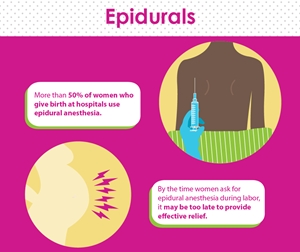
Choosing whether to submit to an epidural is one of the most contentious topics regarding childbirth. On one side of the argument stand natural childbirth proponents, who believe that medical interventions inhibit bonding and chip away at the sacredness of birth. On the other side, you'll find the pro-epidural camp who feel that anything that reduces pain during labor is a godsend. No matter your choice – epidural or not, understanding how the injection works may help you decide how to move forward with confidence on delivery day.
Epidurals are popular
Epidurals are the most common form of pain medication used during labor. In fact, in the U.S., more than 50 percent of hospital births call on this type of pain management. The procedure is simple and can be completed easily in between contractions. Administering an epidural means a highly trained anesthesiologist is called in to inject anesthetic into the space near the spinal cord. While you won't feel contractions once the epidural kicks in, you'll also be numbed from the waist down. That may sound scary, but it's only temporary.
Timing is everything
You may be tempted to beg for pain medications at the first contraction, but know this: Many health care professionals advise against early epidural use. Your doctor or midwife may suggest this type of pain relief only once your cervix has dilated to 4 or 5 centimeters with regular contractions. Any earlier and you may risk slowing down labor and dragging out the process. Epidurals take about 10 to 20 minutes to kick in, meaning that if you wait too long, you may not have the pain relief you need when you're ready to push.
What are you planning for delivery day? Are you pro-epidural or against it? Share your thoughts with other expectant moms in the comments section below.


Leave a Reply